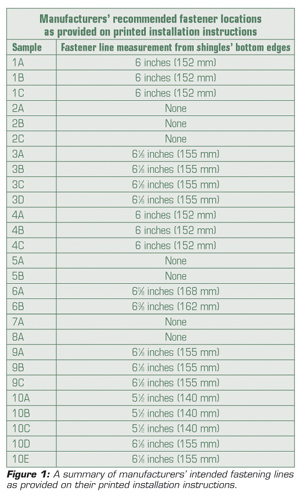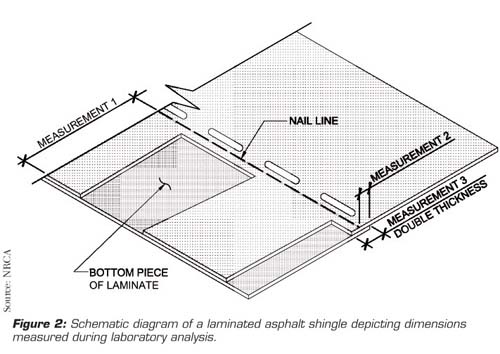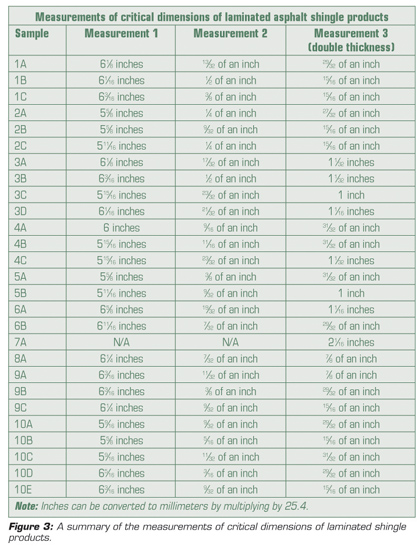NRCA has received a significant number of complaints from contractors stating manufacturers claim a relationship between improper fastener placement and asphalt shingle failures. As a result, NRCA conducted a limited study of architectural, laminated asphalt shingles commonly used in the U.S. roofing industry. One of the study's purposes was to provide some background data for use by NRCA in developing appropriate nail placement tolerances for such shingles.
The current situation
Asphalt shingles enjoy widespread acceptance in the U.S. roofing industry. During the past several years, architectural, laminated asphalt shingle use has surpassed the use of conventional three-tab strip shingles and now is more than half of all asphalt shingle products installed.
In 1998, NRCA began looking into application tolerance guidelines for three-tab strip shingles. This investigation spurred from reports by NRCA-contractor members that several manufacturers were claiming improper fastener placement during application was a reason for failures in specific asphalt shingle roof assemblies. (For additional information regarding fastener placement tolerances, see "Asphalt shingle application tolerances," March 2000 issue, page 106).
With the increased use of laminated asphalt shingles, NRCA has noted a significant increase in the number of problems related to the products. Although a majority of the reported problems can be characterized as similar to those associated with conventional three-tab strip shingles (for example, color shading, granule loss and cracking), some problems are unique to laminated asphalt shingles.
For example, NRCA has received a significant number of reports about the bottommost pieces of some laminated asphalt shingles loosening, becoming detached and falling from roofs. These reports appear to be most commonly associated with south-facing roof elevations and roofs that are relatively steep.
Contractors who reported these problems indicated manufacturers typically claim bottommost pieces of laminated asphalt shingles loosen or fall because the shingles most likely were installed improperly. Typically, placing fasteners too high on shingles is cited as a reason for failure.
To investigate some factors associated with manufacturers' claims about improper fastening of laminated asphalt shingles, NRCA's Technical Operations and Steep-slope Roofing committees authorized NRCA's Technical Services Section to collect samples of laminated asphalt shingles and conduct a limited study.
Sampling and analysis
NRCA obtained 27 laminated asphalt shingle product samples from 10 manufacturers. The samples were obtained by members of NRCA's technical committees from throughout the United States using typical distribution sources. The samples were provided to NRCA in their original bundles with packaging and labeling intact.
Upon receiving the shingle samples, NRCA cataloged and blind-labeled each sample and recorded specific information from manufacturers' installation instructions printed on the package labels.
Figure 1 summarizes manufacturers' intended fastener locations (as described in their printed installation instructions) measured from the bottom edges of the shingles. Samples 2A, 2B, 2C, 5A, 5B, 7A and 8A did not have specifically defined, or measurable, fastener locations provided on their labels and, therefore, "None" is indicated for these samples.

In evaluating fastener placement locations, it is important to realize two fundamentally different sizes of laminated asphalt shingles exist in the U.S. roofing market. Samples 2A, 2B, 2C, 5A, 5B, 10A, 10B and 10C are produced using conventional shingle dimensions (generally 36 inches [914 mm] wide and 12 inches [305 mm] high). The remaining samples are larger, metric-sized shingles, which generally are 39 3/8 inches (1 m) wide and 13 1/4 inches (337 mm) high.
Because exposure dimensions of metric-sized shingles typically are larger than those of conventional-sized shingles, the fastener placement line measured from a shingle's bottom edge typically is greater than that of a conventional-sized shingle.
NRCA provided representative shingles from each bundle to an independent laboratory for inspection and analysis. The laboratory analysis consisted of a thorough visual inspection of the shingles' characteristics and measurements of specific shingle dimensions applicable to fastener placement. The specific shingle dimensions measured are described as follows and are depicted in Figure 2:
- Measurement 1: Dimension from a shingle's bottom edge to the factory-applied nail line
- Measurement 2: Dimension from the factory-applied nail line to the top backside edge of the bottom-most piece of a shingle
- Measurement 3: Width dimension of the double-thickness portion of a shingle above the cut-out portions
Measurements were taken from a minimum of three shingles from each bundle. A steel ruler measuring to the nearest 1/32 of an inch (0.79 mm) was used to determine these measurements.

Results
Figure 3 lists the results for each product included in the study. The data provided in Figure 3 are average values mathematically derived from a minimum of three measurements per product.

Sample 7A did not have a specific fastener placement line imprinted on the shingles; therefore, it was not possible to determine Measurements 1 and 2 for this product.
Comparing manufacturers' intended fastener locations described in their printed installation instructions to what was imprinted on their shingles reveals only Samples 3A, 4A and 6A had identical locations for both. For the remaining products, the average values provided as Measurement 1 vary up to 3/16 of an inch (4.8 mm) from those provided in the manufacturers' printed installation instructions. Consideration of individual (not average) Measurement 1 values reveals even greater variances occur in some individual products.
For example, Sample 1C has individual Measurement 1 values ranging from 5 15/16 inches to 6 3/8 inches (151 mm to 162 mm) on an individual shingle. Similarly, Sample 5B has individual Measurement 1 values varying from 5 3/8 inches to 5 13/16 inches (136.5 mm to 147 mm).
These variances indicate the factory-applied nail lines on individual shingles are not always in the correct locations or positioned parallel relative to shingles' bottom edges.
Evaluation of Measurement 2 data reveals there typically are only small dimensions between factory-applied nail lines and the top, backside edge of double-thickness portions of most laminated shingles. Average Measurement 2 dimensions varied from only 1/4 of an inch (6 mm) for Samples 2A and 2C to 23/32 of an inch (18 mm) for Samples 3C and 4C. These values are indicative of the minimal tolerances for high fastening most laminated asphalt shingles provide.
Studying the results of Measurement 3, which measures a laminated shingle's double-thickness portion, reveals widely varying measurements and, in most instances, only minimal allowances for application tolerances. Although Sample 7A exhibits the greatest double-thickness width of 2 1/16 inches (52 mm), the remaining samples exhibit only minimal double-thickness widths ranging from 27/32 of an inch (22 mm) to 1 1/16 inches (27 mm).
Analysis of results
Most manufacturers require fasteners be placed in the double-thickness portions of their laminated shingle products. In addition to providing the necessary attachment of shingles to roof decks, such fastener placement is said to provide positive mechanical attachment of the bottommost pieces of laminated shingles.
Consider the expectation this places on those installing laminated asphalt shingles.
An applicator is expected to consistently install, for example, standard shingle nails with 3/8-inch- (10-mm-) diameter nail heads in a double-thickness "nail zone" as little as 27/32 of an inch (21 mm) wide. Assuming a best-case scenario where the manufacturer's printed installation instructions and product imprinting provide a fastener line in the exact center of the nail zone, the applicator is provided a hypothetical tolerance for placing fasteners as little as plus or minus 1/4 of an inch (6 mm).
In the event an applicator places nails too low, the result likely will be "shiners," nail heads visible in the exposed portions of shingles. Placing nails too high can result in missing the double-thickness portion.
Clearly, the hypothetical plus or minus 1/4-inch (6-mm) tolerance for installing fasteners onto laminated asphalt shingles is neither practical nor realistically, consistently achievable in the field.
Closing thoughts
Although laminated asphalt shingles enjoy widespread acceptance and use in the U.S. roofing industry, these products provide applicators with only minimal application tolerances, particularly regarding fastener placement.
I encourage contractors who install laminated asphalt shingles to make sure their workers are aware of manufacturers' intended fastener placement locations and any fastener placement tolerances associated with the specific products they install. If necessary, contractors should adjust their crews' work practices as appropriate to the specific product being installed.
At the same time, manufacturers should re-evaluate their laminated asphalt shingle products and installation requirements and tolerances. Because of the minimal nail zones currently provided by most laminated asphalt shingles, manufacturers should not rely on applicators being able to consistently install fasteners in the double-thickness areas to secure the bottommost pieces of laminated shingles. Adequate adhesive should be factory-applied between the laminated shingles layers to prevent laminated asphalt shingles from delaminating in the field.
Also, building owners, project designers and consultants should have realistic expectations of the application parameters associated with laminated asphalt shingle roof assemblies.
NRCA is working closely with several manufacturers to develop realistic application guidelines for laminated asphalt shingle products. And efforts are under way at ASTM International to define minimum dimensions of the double-thickness portions of laminated shingles.
NRCA and Professional Roofing will keep readers abreast of further developments regarding laminated asphalt shingles.
Mark S. Graham is NRCA's associate executive director of technical services.
